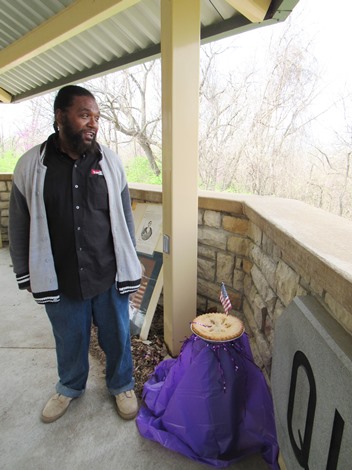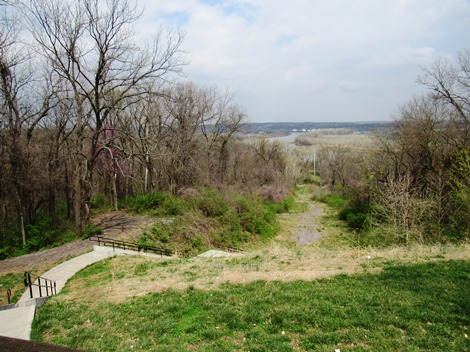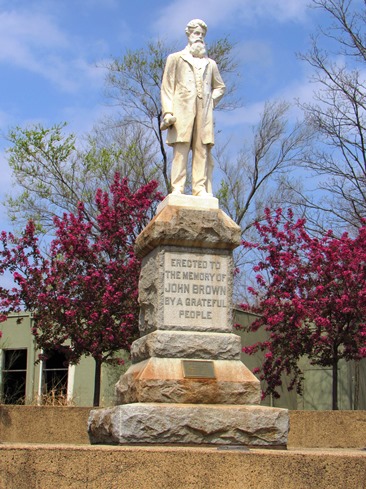
A national landmark designation will be sought for the Quindaro Ruins, having received approval Thursday night from the Unified Government Commission for the process.
The landmark project could lift the historic site into national attention, according to the proposed project manager.
The Quindaro Ruins are an abandoned pre-Civil War town site in Kansas City, Kan., west of the confluence of the Kansas and Missouri rivers.
Quindaro was a Kansas town founded by abolitionists on the Missouri River, across from Parkville, Mo., and the town was a stop on the Underground Railroad. Today the site is the largest archaeological Underground Railroad site in North America.
Townspeople left just before the start of the Civil War, and much of the town burned after Union troops quartered their horses there.

The UG Commission unanimously agreed Thursday night to be the official applicant to the Kansas Historical Society for a grant to work on the project. The grant will fund work to apply for National Historic Landmark status with the National Parks Service. Freedom’s Frontier National Heritage Area, based in Lawrence, Kan., would be the project manager under the grant, according to UG officials.
Marlon Goff, UG interim director of economic development, told the commission Feb. 23 that UG staff members have been holding informational meetings with residents and business owners during the past year. The group is working toward national landmark status for the historic site.
Jim Ogle with Freedom’s Frontier, established in 2006 by federal legislation, said the organization serves 29 counties in Kansas, including Wyandotte, as well as 12 counties in Missouri. It is affiliated with the National Park Service, he said.
He said Marvin Robinson of Kansas City, Kan., has maintained the fire and enthusiasm for moving forward and remembering the Quindaro Ruins’ importance.
Julie McPike, managing director of Freedom’s Frontier, said work on this project started in August of 2015 with a River Trails Conservation meeting at the Quindaro Overlook. The recommendation was national historic landmark designation for the site. A meeting was held afterward at Allen Chapel AME Church about the designation for the church.
Elizabeth Hobson, in charge of education and interpretive grants for Freedom’s Frontier, said currently the Quindaro Ruins and Quindaro town site are listed on the National Register of Historic Places. A national historic landmark designation turns a landmark from local significance to national significance. The designation says the site is not only important to the region but also to the country in the nation’s history, she said.
“It’s going to bring more visibility for the region,” Hobson told the UG Commission. Only 2,500 properties are listed as national landmarks, while there is a much larger number of properties on the National Register of Historic Places.
Hobson said the application process is lengthy, and the first step was completed in late 2015. A letter was written to the Park Service stating they think this is a nationally significant landmark and asking if they could do it. She said the Park Service wrote back in January 2017, after consulting with the Kansas State Historic Preservation Office, community members, and the Wyandot Nation of Kansas, saying that the park service believes this is a valid step to go to, to become a national historic landmark.
“They did have a very clear outline for us going forward,” she said. The National Register nomination from 2002 is not the only story of the Quindaro Ruins; it needs to be broadened and widened, she said.
Besides bringing more visibility to the region, the landmark status could bring in increased opportunity for funding, different grants, tax incentives and more opportunities for technical assistance if listed as a landmark, she said.
If named a national landmark, the Quindaro Ruins could show up in park service magazines, and it could be found in lesson plans in the future, she said.
Finding stories about old Quindaro has been one of the goals of the group. Local history books have chapters about Quindaro, and the pre-Civil War newspaper, the Quindaro Chindowan, has been saved and is preserved at the state historical library. The group now is seeking more stories about Quindaro, including stories handed down in families. They also are looking for artifacts.
Freedom’s Frontier joined with the Kansas City, Kan., Public Library to begin an oral history project, Hobson said. The Main Library at 6th and Minnesota Avenue has resources to record oral histories about Quindaro. On a Saturday in February, there were nine interviews in this Quindaro oral history project at the library, she said. The interviews will be transcribed by volunteers and placed on the KCKPL website, she added.
A public symposium on the historic significance of Quindaro is planned in April 2018, she said, to share the research with the public.
According to Freedom’s Frontier, if they receive the $15,000 grant from the Kansas State Historical Preservation Fund, it will be used to hire a consultant for next year, to help complete the application to the Park Service.
Goff said there is a $15,000 match required from the UG, which he said could be in-kind services, including some of the work the UG already is working on, such as a master plan that covers part of the Ruins area.
Commissioner Gayle Townsend said the grant application on the Thursday night agenda dovetailed with the appearance of the Quindaro Development Corp. at the same meeting to ask for city services such as code enforcement, demolition and upkeep.
She said she hopes the Quindaro Ruins landmark project will help bring the residents in the area together. She also remembered the efforts of the late Jesse Hope, who was the director of the Old Quindaro Museum on 29th Street.
In the late 1980s, she said, the Quindaro Ruins was at risk of being a dump. The effort to turn it into a commercial dump was defeated, and now the Quindaro Ruins are taking another step forward as a historical site.
Commissioner Jane Philbrook also mentioned Jesse Hope’s museum that had operated for several years near the site.
Commissioner Hal Walker said a lot of people have joined in this effort, but only one individual, Marvin Robinson, kept this dream alive for the project.
Walker recalled that former Councilmember Chester Owens was on the council in the 1980s at the time when an effort was blocked to turn the Quindaro Ruins into a landfill. The waste company that wanted to bulldoze the Ruins was within weeks of destroying it when that effort was blocked. Walker said Robinson saw the area’s historical significance long before anyone else.

To see a video of the UG meeting, visit https://www.youtube.com/watch?v=SjXC3EG8W64.
To see an earlier story from 2015 about the Quindaro Ruins history, visit https://wyandotteonline.com/150th-anniversary-of-civil-wars-end-remembered-at-quindaro-event/.
To see the Kansas City, Kan., Public Library’s collection of stories about Quindaro, visit http://kckl.ent.sirsi.net/client/en_US/home/?rm=ARTICLES1%7C%7C%7C1%7C%7C%7C0%7C%7C%7Ctrue.

THANK YOU and BLESSINGS to the Wyandotte Daily, your staff, organization are very much appreciated.
We have a lot of work ahead to complete in order to achieve simple yet, complicated quality historic restoration and preservation of the QUINDARO RUINS / Underground Railroad path towards NATIONAL HISTORIC LANDMARK.
Thanks so very much !!!
Marvin S. Robinson, II
QUINDARO RUINS / Underground Railroad- Exercise 2017